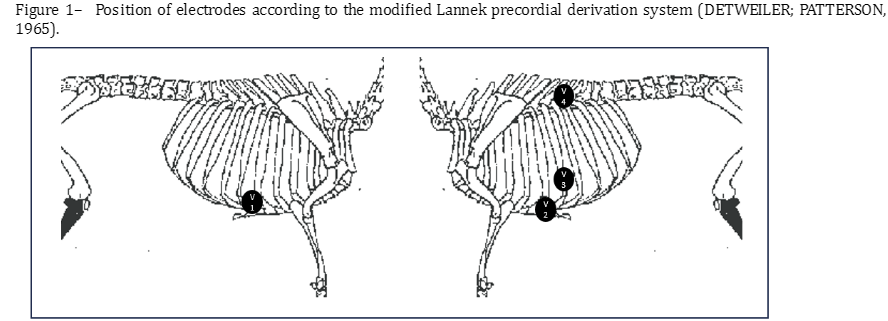Electrocardiographic measurements in Santa Inês sheep
DOI:
https://doi.org/10.21708/avb.2024.18.2.12328Resumo
The absence of normal reference values and electrocardiographic standards for clinically healthy sheep of a particular breed can hinder the detection of various conditions that might affect the transmission of cardiac impulses. This study aimed to determine the values of electrocardiographic measurements in leads D1, D2, D3, aVR, aVL, aVF, V1, V2, V3, and V4 and the effects of age and weight in ewes. The study was conducted with 39 nonpregnant and healthy Santa Inês ewes. They were categorized into four groups according to body weight: 7 ewes (20–30 kg), 14 ewes (30–40 kg), 11 ewes (40–50 kg), and 7 ewes (over 50 kg). There were also categorized into three groups according to age: 6 ewes (10–12 months), 28 ewes (16 and 17 months), and five ewes (2–4 years). Ewes aged 16 and 17 months showed a significant increase in P-wave time compared with ewes of other ages. There was no significant variation in terms of weight among the animals studied (P > 0.05). The reference intervals of electrocardiogram parameters did not show considerable variation in relation to weight and the age range from 10 months to 4 years. This corroborates the standardization of electrocardiographic normality values of unsedated Santa Inês ewes.
Downloads

Downloads
Publicado
Edição
Seção
Licença
Copyright (c) 2024 Acta Veterinaria Brasilica

Este trabalho está licenciado sob uma licença Creative Commons Attribution 4.0 International License.
Autores que publicam na Acta Veterinaria Brasilica concordam com os seguintes termos: a) Autores mantém os direitos autorais e concedem à revista o direito de primeira publicação, com o trabalho simultaneamente licenciado sob a Licença Creative Commons Attribution que permite o compartilhamento do trabalho com reconhecimento da autoria e publicação inicial nesta revista. b) Autores têm autorização para assumir contratos adicionais separadamente, para distribuição não-exclusiva da versão do trabalho publicada nesta revista (ex.: publicar em repositório institucional ou como capítulo de livro), com reconhecimento de autoria e publicação inicial nesta revista. c) Autores têm permissão e são estimulados a publicar e distribuir seu trabalho online (ex.: em repositórios institucionais ou na sua página pessoal) a qualquer ponto antes ou durante o processo editorial, já que isso pode gerar alterações produtivas, bem como aumentar o impacto e a citação do trabalho publicado (Veja O Efeito do Acesso Livre).


 Esta obra está licenciada com uma Licença
Esta obra está licenciada com uma Licença 